The Athlon II X2 & Phenom II X2: 45nm Dual-Core from AMD
by Anand Lal Shimpi on June 2, 2009 12:00 AM EST- Posted in
- CPUs
Adobe Photoshop CS4 Performance
To measure performance under Photoshop CS4 we turn to the Retouch Artists’ Speed Test. The test does basic photo editing; there are a couple of color space conversions, many layer creations, color curve adjustment, image and canvas size adjustment, unsharp mask, and finally a gaussian blur performed on the entire image.
The whole process is timed and thanks to the use of Intel's X25-M SSD as our test bed hard drive, performance is far more predictable than back when we used to test on mechanical disks.
Time is reported in seconds and the lower numbers mean better performance. The test is multithreaded and can hit all four cores in a quad-core machine.
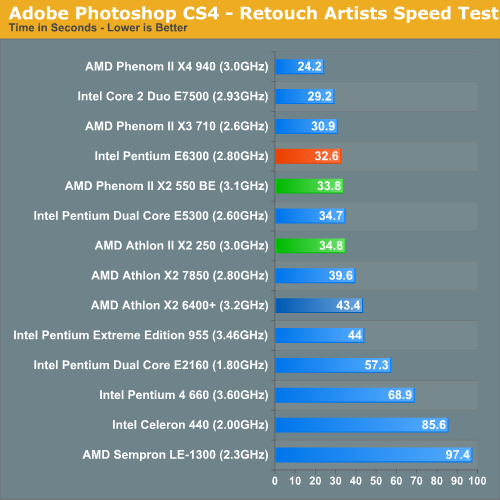
The Pentium E6300 pulls ahead in our CS4 benchmark; it's faster than both the Phenom II 550 and the Athlon II 250. Note the significant increase in performance from the Athlon X2 7850 to the Athlon II X2 250. All of the benefits of the Phenom II architecture are wrapped into the new Athlon II.
DivX 8.5.3 with Xmpeg 5.0.3
Our DivX test is the same DivX / XMpeg 5.03 test we've run for the past few years now, the 1080p source file is encoded using the unconstrained DivX profile, quality/performance is set balanced at 5 and enhanced multithreading is enabled:
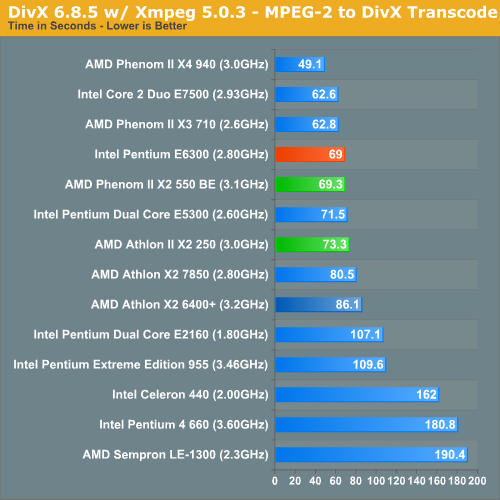
DivX performance is very close between all three contenders. The E6300 and Phenom II 550 are virtually tied while the Athlon II 250 isn't far behind. For faster performance in encoding you need more cores though.
The Pentium EE 955, at one time an encoding monster, is now as fast as a Pentium E2160 in our DivX test.
x264 HD Video Encoding Performance
Graysky's x264 HD test uses the publicly available x264 codec (open source alternative to H.264) to encode a 4Mbps 720p MPEG-2 source. The focus here is on quality rather than speed, thus the benchmark uses a 2-pass encode and reports the average frame rate in each pass.
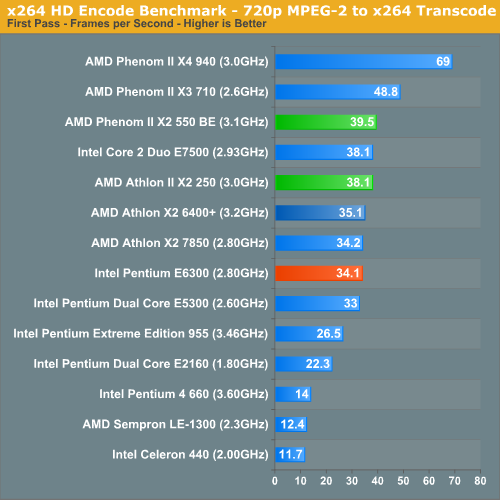
The latest version of the x264 codec fixes the problem exemplified in our first pass results, but these are still interesting to look at. Because of a number of unaligned memory loads all of Intel's pre-Nehalem Core based processors are penalized. The result is both the Athlon II and Phenom II are ahead of the E6300 here.
In the second pass of the test however, things return to "normal". The E6300 is technically in between the two new AMD dual-core chips, but all three basically perform the same. The Phenom II X3 710 adds another 40% to the processor cost and yields an extra ~20% in performance.
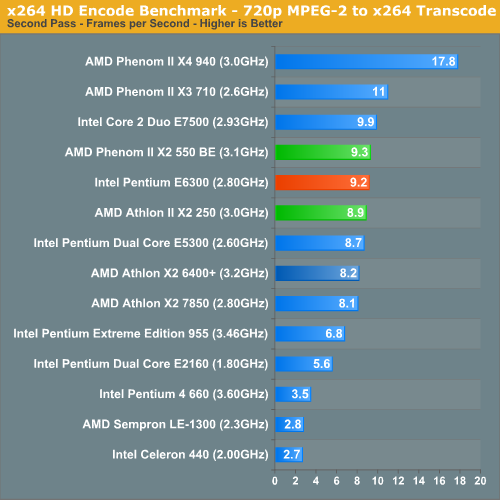
Windows Media Encoder 9 x64 Advanced Profile
In order to be codec agnostic we've got a Windows Media Encoder benchmark looking at the same sort of thing we've been doing in the DivX and x264 tests, but using WME instead.
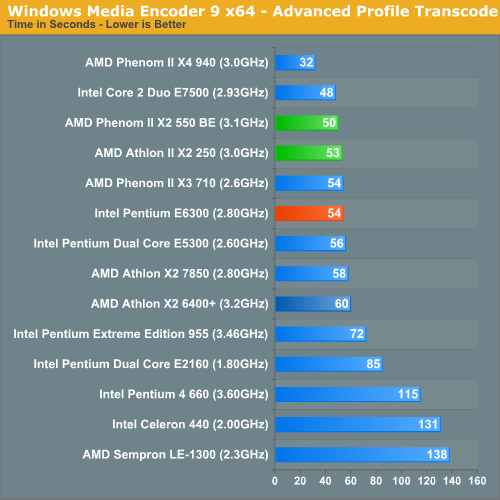
Under WME, both of the AMD chips are a bit faster than the E6300. Note that even the triple-core Phenom II 710 is slower than the Phenom II X2 550; not all applications work well with AMD's odd 3-core configuration.










55 Comments
View All Comments
7Enigma - Thursday, June 4, 2009 - link
Hello Anand,In the article you seem to imply a tremendous difference in that 2meg to 3meg jump but your single data point doesn't show that conclusion.
In your example there is a ~9% increase in performance when going from 2 to 3 megs, but there is also a 4.5% increase in clockspeed between the 2 chips. So at best (in this example) you have a 5% difference, which while significant, I would't say it was tremendous.
Can you comment on whether you did any further tests with identical frequencies?
FlameDeer - Thursday, June 4, 2009 - link
Here are some corrections of AnandTech Bench.Refer to here:
http://www.anandtech.com/bench/default.aspx?b=25&a...">Adobe Photoshop CS4 results of few CPUs from AnandTech Bench
1. AMD Athlon II X2 250 results missing a dot, becoming slower than Intel Atom 230.
2. Better using "Intel Pentium Dual Core E5300" for E5300 as the name Intel printed on the CPU.
3. AMD Athlon LE-1620 notes (platform side notes) should be same as AMD Athlon LE-1640.
Thanks for adding more CPUs for comparison in AnandTech Bench, doing the full test in latest software is really time consuming especially for old CPUs. Take care.
MadAd - Wednesday, June 3, 2009 - link
would have liked to see phenom (non II) compared, especially the low end x3s, users may be thinking of upgrading from those about nowFlameDeer - Thursday, June 4, 2009 - link
You can always conveniently & interactively comparing them here.http://www.anandtech.com/bench/">AnandTech Bench
Elementalism - Wednesday, June 3, 2009 - link
I never had much luck running Cool n Quiet when I used to run AMD processors. Even in games the CPU was put into a low clock mode running at half speed. Sounds like a buggy implementation to this day.And I cant say in my experience it was the Mother Boards fault either. I enabled Cool and Quiet in the bios and nothing happened. It wasnt until I installed the Cool n Quiet driver all hell broke loose.
mino - Wednesday, June 3, 2009 - link
However one has to keep in mind the bug comes from Redmond.The Win 5.x scheduler is a piece of garbage and it allways was. It is just that it shows with different symptoms:
1 CPU core => crappy multi-tasking on heavy loads
2+ CPU cores => unable to get a grasp that power management not a thing of the future ...
A no, being from 2000 is no excuse, proper OS scheduler were there 30yrs ago.
Had MS decided to do so, their Win 5.x schedules would be a proper one from the start.
As for AMD, it is a price one pays for being ahead of the market.
Remember, it took Intel 5yrs (2003-2008) to get comparable power management capabilities as AMD with Nehalem.
mino - Wednesday, June 3, 2009 - link
sorry for the spelling mess..Hrel - Wednesday, June 3, 2009 - link
YAY 3D max, also that E7500 is beating the crap out of everything but AMD's top of the line. That really solitifies in my mind that picking the E8400 6 months ago for my friends gaming computer was the right choice. Stupid AMD, I REALLY want them to be competitive again so Intel is FORCED to stop overcharging for EVERYTHING.mmpalmeira - Wednesday, June 3, 2009 - link
Did you try to overclock the uncore of the AMD's CPUs?calyth - Tuesday, June 2, 2009 - link
Just like that article that you linked to with the name CnQ bug, I don't believe that a hardware manufacturer creates a bug if the OS scheduler can't seem to do the sensible thing and not bounce threads around. Although various factors in the AMD chips make the problem worse, bouncing threads across different cores on an Intel chip also has a bit of impact, since L1 and the L2 shouldn't be shared across cores on the i7 platform.So please, stop calling it a bug. The bug lies in Windows, not the chips.